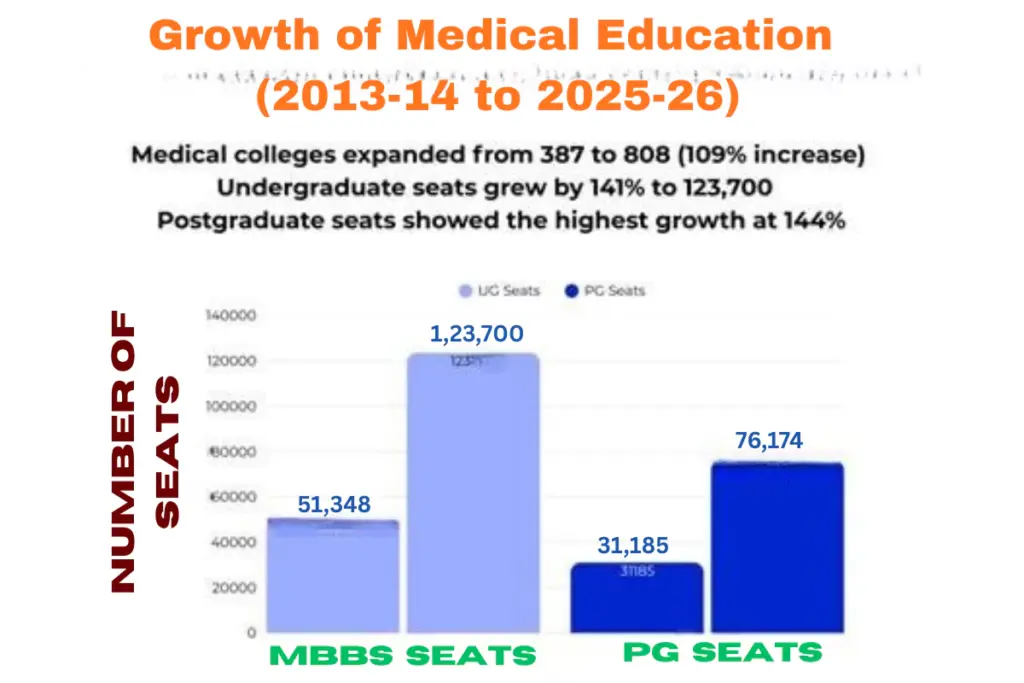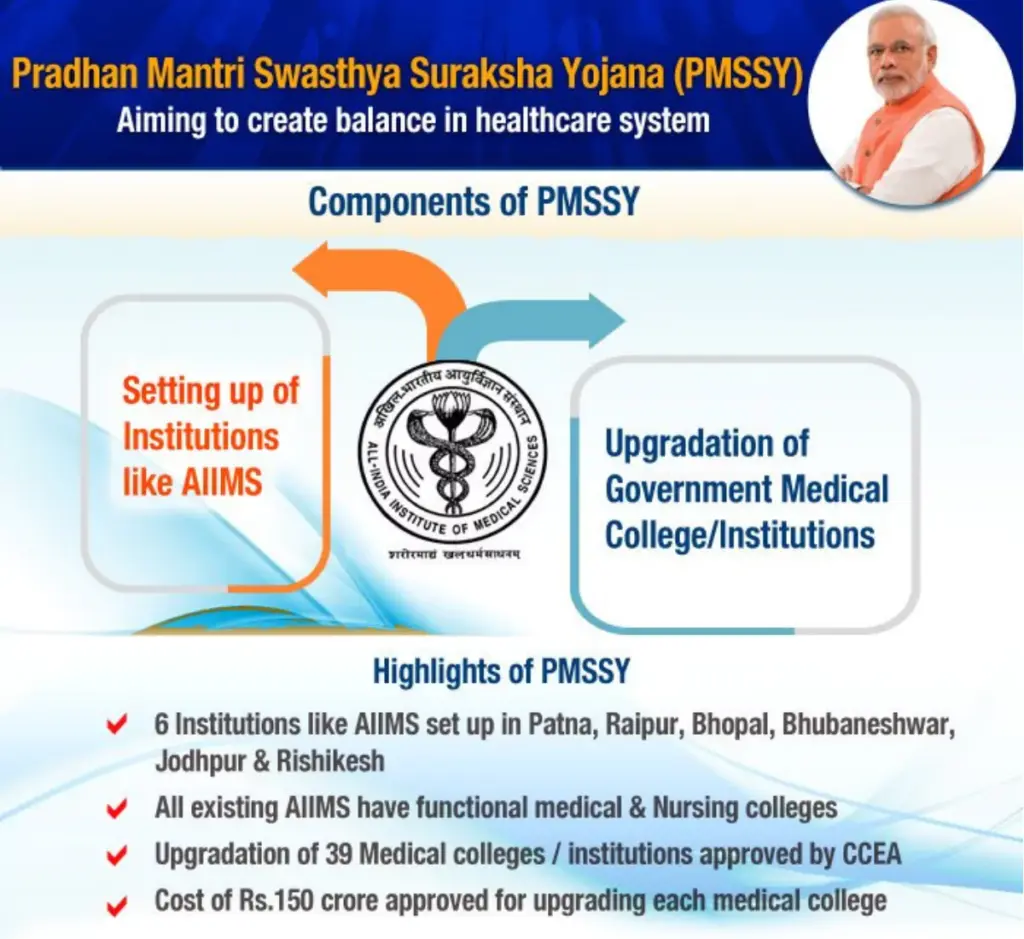Medical Education in India: The National Medical Commission (NMC) has approved 808 medical colleges across India, offering a total of 1,23,700 MBBS seats for aspiring NEET aspirants. This marks a significant milestone in India’s efforts to bridge the gap between the growing demand for healthcare professionals and the availability of trained doctors.
The Union Cabinet of India also approved the Phase III medical college expansion plan. With a strategic focus on both government and private medical institutions, this expansion not only increases access for NEET UG aspirants but also strengthens the country’s healthcare infrastructure and tries to fix the growing MBBS Doctor Crisis in India.
Prime Minister Narendra Modi, in a post on X, September 24, 2025, wrote: “Approval of Phase-III of the Centrally Sponsored Scheme will add significant PG and UG medical seats. This will improve our healthcare system and enhance the medical education infrastructure. It will ensure that every part of India has availability of skilled doctors.”
The jump in NMC-approved colleges and seats ensures more opportunities for students from diverse backgrounds while promoting regional balance in medical education.
NMC Approves 123700 MBBS Seats & 808 Medical Colleges
The National Medical Commission (NMC) has approved 808 medical colleges across India, marking a significant rise from just 381 colleges a decade ago. Today, these colleges offer 1,23,700 MBBS (Bachelor of Medicine, Bachelor of Surgery) seats. This represents a remarkable growth trajectory:
- 69,352 MBBS seats were added in the last decade, marking a 127% increase.
- 43,041 postgraduate (MD/MS) seats were also introduced during the same period, a growth of 143%.
This medical college expansion under CSS Phase1-2-3 reflects India’s commitment to addressing the critical shortage of doctors, especially in rural and underserved areas, to fill Urban-Rural Gaps in India’s Public Health System and ensure more equitable access to healthcare.

Expansion of AIIMS: Strengthening Tertiary Healthcare
Under the Pradhan Mantri Swasthya Suraksha Yojana (PMSSY), 22 new All India Institute of Medical Sciences (AIIMS) have been approved. These institutions aim to:
- Provide affordable and reliable tertiary healthcare across India.
- Improve the quality of medical education in diverse regions.
- Serve as centers of excellence for research and training.

The establishment of new AIIMS institutes complements the growth of other government and private medical colleges, making high-quality medical care more accessible to all citizens.
Key Faculty Reforms to Expand Capacity
Recognising that expanding medical seats requires qualified faculty, the National Medical Commission (NMC) introduced the NMC Medical Institution (Qualifications of Faculty) Regulations, 2025. These regulations are designed to:
- Widen the pool of eligible faculty.
- Facilitate the addition of undergraduate and postgraduate seats.
- Support the Government’s goal of creating 75,000 new medical seats over the next five years.
Some notable reforms include:
Designation of Non-Teaching Hospitals as Teaching Institutions
- Non-teaching government hospitals with 220+ beds can now be recognised as teaching institutions, expanding the infrastructure for medical training.
Flexible Faculty Appointment Criteria
- Existing specialists with 10 years of experience can be appointed as Associate Professors.
- Specialists with 2 years of experience can be appointed as Assistant Professors without completing Senior Residency, provided they finish the Basic Course in Biomedical Research (BCBR) within two years.
- Senior Consultants with three years of teaching experience in NBEMS-recognised government institutions are eligible for the post of Professor.
Read Also: NMC Allows MSc/PhD as 30% of Faculty in 5 Medical Subjects: Its Impact On Medical Education
Simultaneous UG and PG Courses
- New government medical colleges are permitted to start undergraduate and postgraduate courses simultaneously, expediting the training of healthcare professionals and teaching faculty.
Expanded Eligibility for Basic Sciences and Super-Specialties
- Departments like Microbiology and Pharmacology can now appoint faculty with MSc-PhD qualifications.
- Faculty with super-specialty qualifications currently working in broader specialty departments can be formally recognised in their corresponding super-specialty departments.
Read Also: Medical Education in India 2025: MBBS Seat Expansion, AI Integration, and Fee Trends Explained
The Impact of Additional Medical Seats
Recently, 10,023 new medical seats were approved, further reinforcing India’s path toward universal healthcare. This initiative builds on previous efforts to strengthen medical education and healthcare access across the country.
The ripple effects of this expansion are significant:
- Enhanced medical education standards due to improved faculty quality and infrastructure.
- Increased employment opportunities across healthcare sectors.
- Better healthcare access for millions of citizens in rural, tribal, and underserved communities.
- Progress toward turning India into a global medical hub.
Read Also: India’s Medical Education Revolution: NMC Reforms, CBME, NEXT & More
India’s journey to become a world leader in medical education is marked by strategic investments in infrastructure, faculty, and healthcare institutions. The combination of increasing MBBS and postgraduate seats, establishing new AIIMS, and implementing flexible faculty regulations demonstrates the Government’s commitment to addressing the doctor shortage.
With 808 medical colleges, 1,23,700 MBBS seats, and a vision for 75,000 additional seats, India is not only creating doctors but also laying the foundation for a healthier, more resilient nation. These reforms promise better health outcomes, employment opportunities, and global recognition, ensuring that quality medical education and healthcare are accessible to every citizen.



The age of superannuation of medical facilities should be increased upto 72 years in private medical colleges to meet the increased need of medical teachers.
Very True!
Increasing no. of seats is not the only solution to address the health care problems that exist in India. How about quality of education? How about huge private college fees? How about so little internship money, less than the daily wagers, being paid to the interns? We just can’t shut our eyes from the fact that the doctors in India are being underpaid than their counterpart in other countries. Add to that the pro ong work, no rest, stress and strained family life.
This is horrendous
MBBS seats in private colleges are getting expensive day by day..so opening more and more private colleges is only for wealthy students.
BAMS
Just like our population medical colleges are increasing in numbers, but India still have only FIVE Internationally recognised colleges. So nothing to boast about, just a number gimmick
True, global recognition is still limited. But the expansion of medical colleges has improved access for NEET aspirants. The next big challenge is improving quality, research, and international rankings.
Increasing the numbers will only create problems. Quality has to improve. Doctors are not created in factory. Most of the MBBS doctors are jobless. Condition is similar to that of MBA’s. PG admissions are difficult and very expensive. Toxicity in medical colleges is increasing day by day. Faculty quality is pathetic. Those taking decisions to increase the numbers must understand that system first and work on quality of the system before increasing the numbers. Except few colleges, medical education in most of the Indian colleges is not systematic.
You’ve raised some valid points. Increasing the number of MBBS seats alone cannot solve India’s healthcare challenges, quality of education, faculty competence, clinical exposure, and proper infrastructure are equally crucial.
However, the government is attempting a dual approach: expanding seats to meet doctor-patient ratio needs while also encouraging regulatory reforms to improve quality. The system isn’t perfect yet, but with careful monitoring, better faculty training, and stricter NMC oversight, expansion can coexist with quality improvement.
Ultimately, the goal should be more doctors AND better-trained doctors, not just numbers.
India has a long way to go to reach the fully developed Standards of doctors and specialists available where Scandinavian countries have 50 specialists per 1000 citizens. Many thousands of new big super speciality hospitals are required to be built in Class, 2, 3, 4 towns with populations of up to 50000. The intake of MBBS must be increased to over 5. -6 Lakhs progressively with FDI from countries like the US, Germany, Britain, France, Japan and Australia. The yearly output of Specialists and superspecialists needs to be increased to 2.5 to 3 lakhs and similarly very large-scale expansion of nursing colleges medical technicians, operators maintainers hospital management is the need of the hour. For Scully India developed the target for Lifespan must be set at over 85 years in urban areas and 80 in rural areas. The govt budgets for medical hospitals MBBS training specialist training nurses and technicians training need to be increased 10-fold progressively to achieve world-class medical treatment to all its Citizens at affordable and cheap rates with a bulk of the people insured from the present low levels. Medical insurance for all must be made compulsory with companies paying premiums all year round and the poor and lower middle class given a government subsidy and premiums paid.
You are absolutely right, India’s healthcare system needs massive structural expansion, not just more MBBS seats. To reach standards like Scandinavian countries, we need:
1. More specialists & super-specialists (2-3 lakh yearly output).
2. Super-specialty hospitals in smaller towns and tier-2/3 cities.
3. Expanded nursing, medical technician, and hospital management training.
4. Universal health insurance with government support for the poor.
5. Progressive increase in government budgets for healthcare infrastructure and education.
Increasing MBBS intake is only one part of the solution. Comprehensive planning, international collaboration, and funding reforms are essential to make world-class healthcare affordable and accessible to all Indians.